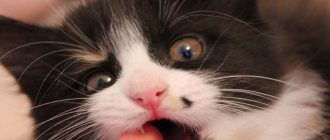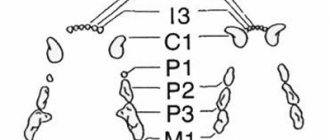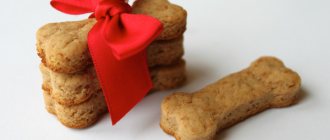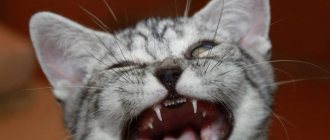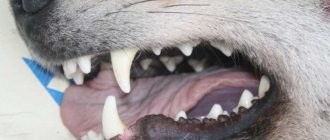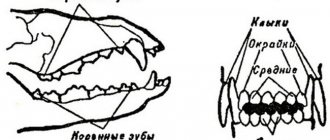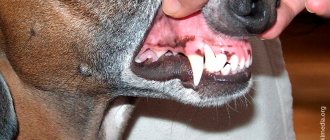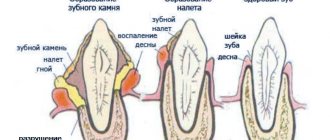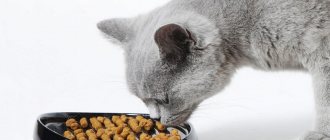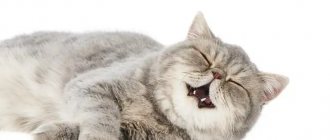Features of tooth growth in kittens
Many owners of small kittens are interested in the forums: do purrs have milk teeth and how many times a cat’s teeth change during their life. To find the answer to these questions, you need to know the characteristics of teeth changing in cats.
At what age do kittens get teeth?
Kittens are born mostly toothless. Their baby teeth erupt 1–2 weeks after birth. By two months, the little purr already has 26 scars. They grow slowly and this process is naturally accompanied by itching.
During this period, cats are quite restless - they constantly strive to chew anything in their field of vision, thus scratching their itchy gums.
When do kittens change teeth?
The change of teeth in small kittens occurs once in a lifetime. Baby teeth fall out and are replaced with permanent new ones. The table shows in what order and at what time periods purrs under one year of age can change their teeth:
| N p/p | Kinds | Approximate shift dates | Number of teeth in an adult cat |
| 1 | Incisors | 4–5 month | 12 |
| 2 | Fangs | 4–6 month | 4 |
| 3 | Premolars | 5–6 month | 10 |
| 4 | Molars | Last ten days of the sixth month | 4 |
If the incisors and fangs fall out in a pet older than one year of age, this indicates the development of some kind of pathology.
Do kittens lose their baby teeth?
Between the ages of three and five months, pets begin to lose their baby teeth. In general, changing teeth is a natural process. True, this period is quite long - it usually ends by seven months.
Symptoms of teeth changing and erupting
Teething, as well as the replacement of milk teeth with permanent teeth in representatives of the cat family, is often accompanied by the following symptoms:
- ptyalism;
- decreased physical activity;
- mild excitability;
- bad breath;
- increase in body temperature by 0.5-1C;
- the emergence of a need to chew various objects.
Based on these signs, a loving owner can easily understand that the kitten has begun the process of teething. It is important for each owner to determine the age of change of incisors and canines in cats in order to avoid various health problems for the pet.
Gum condition
Pain in the gums may occur after the anesthetic drug wears off, that is, after 3-4 hours. After the procedure, the patient is often worried about the return of painful sensations and the release of ichor (for 4–6 hours. After the operation, the wound looks quite scary, especially if a wisdom tooth was removed.
In the absence of pathology, the healing process occurs in several stages.
Kitten care
When replacing milk teeth with permanent ones, caring owners should create special conditions for keeping the cat, its nutrition, oral hygiene and general purring behavior.
Kitten oral hygiene
A cat should be accustomed to cleaning from the first months of life, so as not to be tormented later with an adult cat. Veterinarians advise starting with a game - let the little purr get used to his toothbrush. This way he won't be afraid of her.
Later, the kitten will even appreciate the opportunity to scratch his itchy gums on the bristly surface of the brush.
Hygiene procedures for the kitten's oral cavity should be performed 1-2 times a month. This procedure is an excellent prevention of periodontitis and tartar.
Nutritional Features
A small pet should be fed taking into account its age characteristics, regardless of the replacement of fangs. Caring owners should know that the health of a kitten’s oral cavity is promoted by food rich in phosphorus, calcium, as well as vitamins A and D. The cat will benefit from: boiled lean meat and fish, rice and oatmeal, milk, kefir, cottage cheese, pumpkin and zucchini.
When feeding industrial food, preference should be given to products made directly for kittens. Such food contains a balanced vitamin and mineral complex, specially designed for the growth of a young cat's body.
By eating such food, the kitten receives the proper amount of microelements necessary for oral health.
How to behave with a pet
Itching in the gum area during the eruption of incisors and fangs always causes stress in kittens. During this period, owners are encouraged to correct the cat's behavior. You should not allow your cat to chew on anything - this can harm the baby’s health.
During these several months, it is better not to vaccinate the purr, so that the vaccination does not harm its health.
After 2–3 months and beyond
The gum gradually hardens, and the space remaining from the tooth is filled with maturing bone tissue. By the beginning of the 4th month, the gum bone tissue completes its formation. The gum can be called completely healed.
If the wound heals with suppuration, then healing of the wound can last up to six months.
Possible complications when changing teeth
The replacement of baby teeth with permanent ones is a common natural phenomenon in kittens. It is mostly asymptomatic. Unless your gums may turn slightly red. However, monitoring of the kitten's condition will be required.
Contacting a veterinary clinic is necessary if you notice non-healing festering wounds in the mouth, a bad mood in the cat, loss of appetite, suppuration on the gums, or the appearance of wounds near the grown permanent incisors or fangs.
A doctor’s help is also needed if new teeth erupt before baby teeth fall out.
Oral diseases in cats
A big problem when teething with incisors in cats is severe inflammation of the gums.
Gum inflammation
Prolonged inflammation of the gums in cats when changing teeth is characterized by the following signs:
- restless cat behavior;
- refusal to eat due to pain in the mouth;
- ptyalism;
- swelling and noticeable redness of the gums.
Carrying out the procedure
The tooth extraction procedure is carried out using effective, modern painkillers, so, as a rule, there is no pain during the operation itself.
The operation begins immediately after the anesthesia takes effect. A scalpel is used to loosen the ligament supporting the tooth.
If the procedure was traumatic, or the edges of the wound are too wide, the dental surgeon may use self-absorbing sutures. But most often, the wound is simply closed with a gauze pad with a special hemostatic agent. To stop bleeding, you need to lightly but firmly press the tampon onto the wound with closed jaws. After 20 minutes, the gauze can be spat out.
Causes of tooth loss in adult cats
Causes of loss of fangs with incisors in an adult cat:
- injuries or infectious diseases in the oral cavity;
- weakened immune system;
- lack of vitamins;
- diabetes;
- tartar;
- metabolic problems;
- pregnancy;
- therapy with hormonal veterinary drugs (antibiotics or contraceptives);
- incorrectly formed bite;
- stomatitis, periodontal disease, gingivitis, or other dental diseases;
- serious stomach or intestinal problems;
- oncology.
There is an opinion that cats lose teeth due to age and their loss in pets over 8 years old is a natural phenomenon. This version is wrong.
Cats lose their incisors and canines from old age when they reach the age of 20, but rarely does any individual live to such years.
How to help a cat
If a cat's teeth are falling out, owners should monitor the cat for changes in behavior and additional pathological symptoms. Any signs noted must be reported to your veterinarian. This data will be required for the correct diagnosis and subsequent prescription of effective treatment for the furry patient.
Depending on the cause of the loss of incisors and fangs, the doctor will be able to offer the following methods of solving the problem:
- Prescribing a special diet.
- Prescription of immunostimulants.
- Treatment of gum diseases.
- Removal of tartar under “premedication” or general anesthesia.
- Treatment of the underlying disease.
Treatment: what the doctor prescribes
Therapy is selected individually, taking into account the reasons that led to such changes. The main goal of its implementation is to eliminate the provoking factor and normalize the animal’s condition.
Nutrition correction
The first thing to do is to adjust the animal’s diet.
It is extremely important that the menu is balanced . It should contain a sufficient amount of vitamins and microelements.
Tartar removal
If necessary, remove hard plaque under anesthesia. The pet is conscious, but cannot offer resistance.
Upon completion of the process, the cat needs to be provided with complete care. The procedure is very stressful for him.
Treatment of the underlying disease
The main emphasis is on eliminating the pathology that provoked tooth loss. For this purpose, immunostimulating, anti-inflammatory drugs and antibiotics can be prescribed. The therapy is aimed at strengthening the gums, eliminating bleeding and pain.
What to do at home
The owner is required to strictly follow the veterinarian's instructions. Self-medication is dangerous for the cat’s health and can cause irreparable harm to it. Medicines and their dosage are determined by a specialist.
In order for the animal to lead a normal lifestyle, it is necessary to change the consistency of the food, since dry hard granules can further injure the oral cavity.
The oral cavity is regularly examined and treated with a disinfectant solution of Chlorhexidine. These procedures prevent infection of the enamel and damage to other teeth.
Gum healing process
The speed of gum healing depends on several factors:
- individual characteristics of the patient’s immunity;
- the success of the operation;
- location of the extracted tooth.
If the tooth is in a hard-to-reach place, has crooked roots, or its crown has been significantly damaged, then the removal procedure becomes more complicated. During manipulation, the tooth may begin to crumble, leaving fragments in the gum. In this case, it is necessary to cut the gum tissue, detach it from the bone, remove the tooth in parts, and use a drill. These traumatic procedures prolong the period of gum healing after surgery.
Slight swelling of the gums is considered normal. The temperature may rise slightly (due to an immune reaction). The swelling usually subsides within three days.
Noticeable swelling of the gum is also observed after cutting it. This swelling goes away in about one week.
How to motivate your child to brush their teeth
The variety of oral care products today is so great that teaching a child about dental hygiene has become much easier than before. Beautiful toothbrushes with favorite cartoon characters on the body, “delicious” toothpastes, mobile applications that turn brushing into a game - all this helps to develop pleasant associations. Brush your teeth together and praise your child for how well he does it.
Oral-B Vitality Kids Frozen D100.413.2K
Oral-B Pro 2 Junior Sensi Star Wars D501.513.2
Philips Sonicare For Kids HX6322/04 (HX6392/02)
Xiaomi Soocas Kids C1
Make sure that you spend at least two minutes brushing your teeth - place an hourglass on the sink, use a toothbrush with a built-in timer, or a special application on your smartphone.
An effective tool for caries prevention for children is plaque indicators. These are tablets and liquids that color the plaque in bright colors. This way, you can understand which areas need special attention when brushing and whether it’s time to contact a specialist, and the child will have a lot of fun looking at his multi-colored teeth. And he will probably want to repeat the cleaning with better results!
miradent Plaque Agent Plaque Indicator Rinse
Curaprox PCA 223 plaque indicator tablets
miradent Mira-2-Ton Plaque Indicator
miradent Plaque Check dental mirror
Take your child to a dental hygienist - clinics tell you well and clearly about how to care for your teeth and what will happen if you don’t. In addition, children are often motivated by themed cartoons. Show that you can take care of your teeth with pleasure - and the child will do it without unnecessary coercion.
All the most necessary hygiene products for children from 8 to 13 years old are collected in our children's set No. 3. It includes: an electric brush with Frozen or Star Wars cartoon characters, two toothpastes, preventive foam with calcium to strengthen enamel, chewing gum with xylitol and tablets for plaque indication. These are basic products that will help your child maintain healthy oral microflora and fight tooth decay.
When is veterinary help needed?
The owner should focus on the pet’s well-being and his own common sense. Often, symptoms when kittens change teeth make the owner worry about the baby’s health.
Veterinarians are quite loyal to situations when the owner brings a healthy kitten to the appointment to make sure that everything is fine with him. This is definitely better than not seeing a doctor when you definitely need his help.
Regarding the change of teeth, a veterinarian is definitely needed in the following situations:
- the wound on the site of the former baby tooth has festered;
- the cat meows pitifully, cannot sleep, is worried;
- the animal is very lethargic;
- the kitten does not eat for more than a day;
- the baby's mouth smells bad;
- the gums are very inflamed;
- a new tooth or an old one displaced under its influence injures the kitten;
- the baby tooth never fell out, but the gums around it were inflamed;
- the cat has not gone to the toilet for more than a day (he scratched his teeth on something, bit off a piece, and it got stuck in the intestines);
- Some of the baby teeth have not fallen out, although the permanent ones have already grown in and the time for changing teeth has passed.
Deterioration in health cannot always be attributed to the teeth; perhaps the pet is sick. A doctor's consultation will be required in the following situations:
- The smell becomes disgusting, which signals severe inflammation and the development of periodontal disease.
- The kitten sleeps poorly, does not eat for more than a day, and becomes apathetic or restless. A possible reason for this behavior is severe pain in the gums.
- Saliva is secreted excessively, thickens, hangs out of the mouth, which causes the fur on the chest to become wet. This indicates a possible inflammation of the oral mucosa - gingivitis, stomatitis.
The pet's mouth is regularly examined; normally, the surfaces remain smooth, pink, and without damage. Help is needed when deviations are noticed:
- the gum is inflamed around the temporary tooth;
- the hole festered;
- the “milk jug” has shifted and injures the mucous surfaces;
- some children’s teeth remain when the permanent ones are fully grown;
- after 7 months a double row was formed;
- The gums are red and bleeding.
In case of inflammation, they do not give medicine, but take the pet to the clinic. Only a veterinarian will be able to properly examine the mouth, assess the degree of inflammation, and prescribe medications without harm to the animal’s health. “Excess” teeth are removed in the clinic under anesthesia if they damage the mucous membranes, form an incorrect bite, or remain in the mouth after 8–9 months. Stunted growth, when milk has already fallen out, indicates a lack of microelements.
How to prevent the disease from appearing?
But don’t despair – you can always help your cat. Firstly, it should be understood that diseases of the oral cavity leading to tooth loss, like other ailments, are much easier to prevent than to take a long and expensive time to treat. After consultation with a doctor, wiping the cat’s teeth and gums with 0.05% chlorhexidine is often used to prevent the disease. You can purchase the product at a pharmacy without a prescription.
In addition, the procedure for brushing the animal’s teeth should be as mandatory as for the owner himself. In veterinary pharmacies, special brushes and toothpastes for cats are in great demand, with the help of which the procedure is easy for humans and comfortable for a furry pet.
The appearance of at least one of the above symptoms of oral disease without proper attention can lead to the animal losing its teeth. Take the health of our little brothers seriously, because we are always responsible for them.
We recommend reading: Treatment and prevention of tartar in cats
Why does the bite change with age?
Not only the bite changes, but also the entire dental apparatus. This is because bone density decreases as you age (after about 40 years of age).
Bone tissue is constantly renewed. Two types of cells are responsible for this process - osteoblasts and osteoclasts. Osteoblast cells create new tissue, and osteoclast cells destroy old tissue. At a young age, these processes are in balance, and at an older age, the processes of resorption (destruction) begin to predominate. This happens to all bones, so in old age a person’s bone mass and density decreases. After age 50, bone loss is approximately 2% per year.
Thinning of the jaw bone is visible in the image
In general, this process cannot be stopped, just like aging, but there are nuances. Those organs and systems that experience adequate functional load age more slowly.
This applies to teeth like this: if all the teeth are preserved, they constantly experience stress when chewing (that is, a person eats a variety of foods, including hard foods), the roots of the teeth “transfer” this load to the jawbone. Thanks to this, the bone functions normally, and resorption processes proceed slowly.
It is possible to keep your teeth healthy in old age, but with proper care
If some of the teeth are lost, chewing becomes difficult, so the person is forced to eat soft food. The functional load becomes less intense, which means that the jaw bones are not loaded as much as they should. In those areas where teeth are missing, the bone degrades even faster, its volume and density decrease.
“Age-related” changes: what does it look like?
Of course, these processes occur gradually and it is impossible to notice them immediately, but typical changes are still observed over time.
- The height of the crowns decreases.
With age, tooth enamel gradually wears down and teeth become more square. If the nutrition of the roots of the teeth is insufficient (and this occurs due to the weakening and thinning of the jaw bone), then the enamel is not renewed, so its thickness on the cutting edges of the teeth decreases. This happens even with a correct bite, and if there are violations, for example, asymmetrical closure, then on one side the enamel will suffer even more.
Here is an example of what an “aging” smile with a reduced crown height looks like, and what results can be achieved after treatment.
Before and after restoration of dental crowns
- The remaining teeth decay faster.
If a tooth is lost and a prosthesis is not placed in its place, the neighboring teeth will move towards the free space from this tooth. In the area where it is lost, the bone thins out more than in other areas, so the roots of the teeth, receiving less support, may begin to loosen. As a result, tooth displacement can lead to malocclusion.
- TMJ dysfunction develops.
When the load is incorrectly distributed, the temporomandibular joint, the junction of the skull with the movable lower jaw, begins to suffer. Due to the increased load on one of the joints (with bite asymmetry), the masticatory muscles become overstrained and pain occurs. Chronic inflammation occurs in the joint, due to which the surrounding tissues swell and the articular cartilage is gradually destroyed. When the bite is corrected, the function of the TMJ is restored, normalizing the load on the joint. Sometimes, to fully restore function, you need to work together with a gnathologist and consult other specialists, but an integrated approach gives the best results.
- Periodontitis develops.
This is a disease in which degenerative changes occur in the jaw bones and gums. It develops gradually, imperceptibly, but leads to loosening of the teeth. The gum line rises, exposing the neck of the tooth - the transitional part between the crown and roots.
Periodontitis
